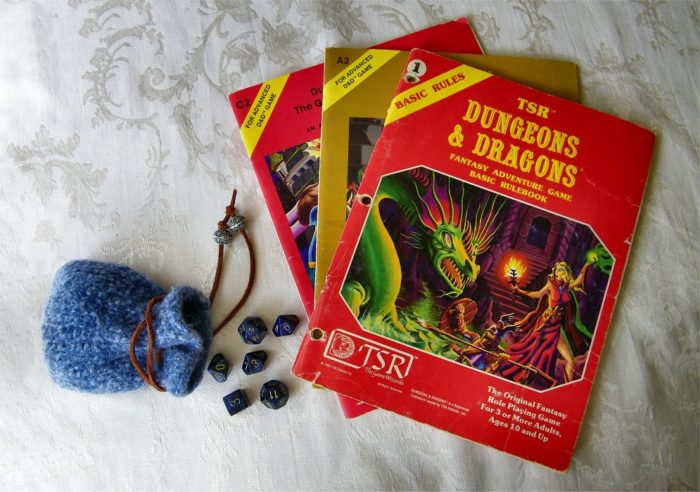With the player’s initiative roll, the battle commences. The brave knights take out their swords and charge at the hobgoblin horde, none expecting to come out alive. The hobgoblins’ attacks are fierce, but they fail their saving throw against the wizard’s fireball spell, and a score of them perish in the blaze. Meanwhile, on the rocky ridge surrounding the battlefield, a platoon of elven archers ready their bows to rain down pointy death upon the monstrous army. All of this happens in a single round of Dungeons and Dragons
Dungeons and Dragons (or D&D for short) is a classic. It was the first-ever tabletop role-playing game – basically, make-believe for adults. Using exotic dice like the famous D20 (or twenty-sided die) and little miniature knights and wizards, the players can pretend to be heroes fighting monsters and villains in a fantasy setting. However, while the ‘default’ settings of D&D are based on the sword and sorcery genre, nothing is stopping a creative dungeon master from incorporating elements from other genres like horror (a la Ravenloft) or science fantasy (a la Spelljammer).
How did this game come about? Its creators Gary Gygax and Dave Arneson based the idea on a previous game Gygax developed called Chainmail. Back then, miniature wargaming, the quasi-realistic simulation of warfare using miniature physical models to represent military units, was a phenomenon. Wargaming players would go to conventions to network with other players and partake in what was then a niche hobby. At first, most of these wargames simulated the Napoleonic and American Civil Wars. But in the 1950s, British author J. R. R. Tolkien’s epic trilogy The Lord of the Rings helped stir the imagination of these wargamers, leading to the development of rules for playing medieval and Roman-era wargames. Chainmail was certainly following a trend when it was created in 1971. What stuck out, however, was the “fantasy supplement” which included heroes, superheroes, wizards, and mythical creatures like elves, orcs, and dragons. The fantasy supplement encouraged players to draw on inspiration from the works of popular fantasy authors such as J. R. R. Tolkien, Robert E. Howard, Poul Anderson, Michael Moorcock, and more. Their works would later become an inspiration for D&D as well.
Gygax and Arneson came up with the idea of adjusting a wargame such that each player would control a single character rather than a military formation. They combined many elements that existed in the time – wargaming, fantasy, and improvisational theater – into a single, unique experience. As you could imagine, the list of literary works Dungeons and Dragons referenced or drew upon was extensive. Certainly, J. R. R. Tolkien’s creations loom large. D&D’s halflings, treants, and balors are copyright-friendly versions of Tolkien’s hobbits, ents, and balrogs. Furthermore, the images Gygax and Arneson used to describe elves, dwarves, orcs, and rangers bear a remarkable resemblance to Tolkien’s vision. However, I’d be remiss if I were to claim that Gygax’s creation was simply Middle Earth with the serial numbers filed off. Dungeons and Dragons drew upon Jack Vance’s Dying Earth stories to create its magic system and Poul Anderson’s Three Hearts and Three Lions for its original alignment system. The world of D&D itself was a mishmash of mythology, history, pulp fiction, and contemporary fantasy novels.
I enjoy playing D&D with friends in my spare time because it allows for a great deal of creativity. It allows you to mix and match elements from different fantasy, science fiction, and historical fiction stories to create something unique and interesting. It has captivated me ever since my father introduced it to me as a kid. He showed me the old notes he wrote from the times he played with his brother. It was a huge map of an underground cavern. The story behind was simple: a man comes up to the heroes with a map and then says something like “If you follow this map, it’ll lead you to treasure.” Simple-sounding? Sure, but that’s all it took for my imagination to run wild.
Dungeons and Dragons is a good game to pass the time. I find myself being drawn into this game for hours and hours. Even when I’m not with friends, I wind up spending hours creating characters, monsters, and entire worlds with their own history, politics, and religion. I create elaborate storylines with dastardly villains and helpful allies to engage with my players’ characters. I make puzzles, tricks, and traps for them to overcome. And when I can’t think of anything, I look to a random table and let the dice decide for me.
One might claim that this game is a total time sink. “Why would you waste your time on something like that?” One might ask. I’d reply by asking “Well, what would you want me to waste my time on?” I find that too many people find themselves sucked into not using their time on truly fun things. When work tires you out, you tend to come home and lay about on the couch like a vegetable. This might seem like a good way to recover energy, but it’s not truly leisure. Leisure is supposed to be enjoyable, a way to unwind.
While it’s important to manage one’s time wisely and make sure you spend enough time doing important things, leisure time is also important. Many good things are bad if you have too much of them, and leisure is no exception to this rule. That’s another reason I find that D&D is a great way to spend your leisure time. All it takes is an hour or two of preparation per week and a couple of hours in the evening playing the game with a group, and you’re set. You don’t have to spend hours and hours like some groups do, especially if it’s just a casual game. That said, I won’t blame you if you have so much fun that the time flies. I know it does for me!

Leave a Reply